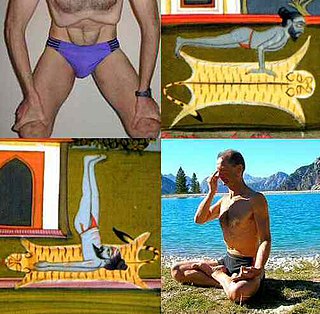
Hatha yoga is a branch of yoga that uses physical techniques to try to preserve and channel vital force or energy. The Sanskrit word हठ haṭha literally means "force", alluding to a system of physical techniques. Some hatha yoga style techniques can be traced back at least to the 1st-century CE, in texts such as the Hindu Sanskrit epics and Buddhism's Pali canon. The oldest dated text so far found to describe hatha yoga, the 11th-century Amṛtasiddhi, comes from a tantric Buddhist milieu. The oldest texts to use the terminology of hatha are also Vajrayana Buddhist. Hindu hatha yoga texts appear from the 11th century onward.

Eugenie Peterson, known as Indra Devi, was a pioneering teacher of yoga as exercise, and an early disciple of the "father of modern yoga", Tirumalai Krishnamacharya.

K. Pattabhi Jois was an Indian yoga guru who developed and popularized the flowing style of yoga as exercise known as Ashtanga vinyasa yoga. In 1948, Jois established the Ashtanga Yoga Research Institute in Mysore, India. Pattabhi Jois is one of a short list of Indians instrumental in establishing modern yoga as exercise in the 20th century, along with B. K. S. Iyengar, another pupil of Krishnamacharya in Mysore. Jois sexually abused some of his yoga students by touching inappropriately during adjustments. Sharath Jois has publicly apologised for his grandfather's "improper adjustments".

Ashtanga vinyasa yoga is a style of yoga as exercise popularised by K. Pattabhi Jois during the twentieth century, often promoted as a dynamic form of classical Indian (hatha) yoga. Jois claimed to have learnt the system from his teacher Tirumalai Krishnamacharya. The style is energetic, synchronising breath with movements. The individual poses (asanas) are linked by flowing movements (vinyasas).

Bellur Krishnamachar Sundararaja Iyengar was an Indian teacher of yoga and author. He is founder of the style of yoga as exercise, known as "Iyengar Yoga", and was considered one of the foremost yoga gurus in the world. He was the author of many books on yoga practice and philosophy including Light on Yoga, Light on Pranayama, Light on the Yoga Sutras of Patanjali, and Light on Life. Iyengar was one of the earliest students of Tirumalai Krishnamacharya, who is often referred to as "the father of modern yoga". He has been credited with popularizing yoga, first in India and then around the world.
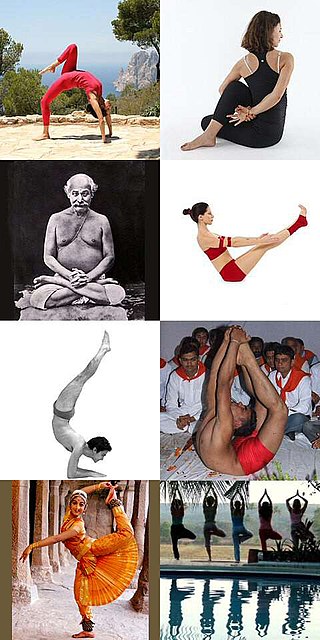
An āsana is a body posture, originally and still a general term for a sitting meditation pose, and later extended in hatha yoga and modern yoga as exercise, to any type of position, adding reclining, standing, inverted, twisting, and balancing poses. The Yoga Sutras of Patanjali define "asana" as "[a position that] is steady and comfortable". Patanjali mentions the ability to sit for extended periods as one of the eight limbs of his system. Asanas are also called yoga poses or yoga postures in English.

Sun Salutation, also called Surya Namaskar(a) or Salute to the Sun (Sanskrit: सूर्यनमस्कार, romanized: Sūryanamaskāra), is a practice in yoga as exercise incorporating a flow sequence of some twelve linked asanas. The asana sequence was first recorded as yoga in the early 20th century, though similar exercises were in use in India before that, for example among wrestlers. The basic sequence involves moving from a standing position into Downward and Upward Dog poses and then back to the standing position, but many variations are possible. The set of 12 asanas is dedicated to the Hindu solar deity, Surya. In some Indian traditions, the positions are each associated with a different mantra.
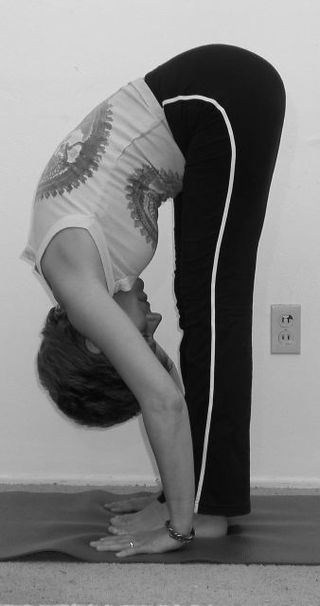
Uttanasana or Standing Forward Bend, with variants such as Padahastasana where the toes are grasped, is a standing forward bending asana in modern yoga as exercise.
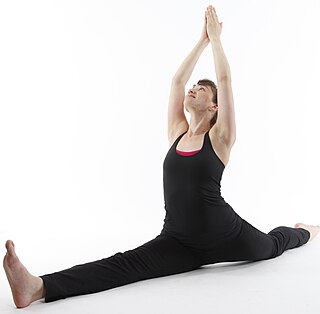
Hanumanasana or Monkey Pose is a seated asana in modern yoga as exercise. It is the yoga version of the front splits.
A vinyasa is a smooth transition between asanas in flowing styles of modern yoga as exercise such as Vinyasa Krama Yoga and Ashtanga Vinyasa Yoga, especially when movement is paired with the breath.
Modern yoga is a wide range of yoga practices with differing purposes, encompassing in its various forms yoga philosophy derived from the Vedas, physical postures derived from Hatha yoga, devotional and tantra-based practices, and Hindu nation-building approaches.

Yoga as exercise is a physical activity consisting mainly of postures, often connected by flowing sequences, sometimes accompanied by breathing exercises, and frequently ending with relaxation lying down or meditation. Yoga in this form has become familiar across the world, especially in the US and Europe. It is derived from medieval Haṭha yoga, which made use of similar postures, but it is generally simply called "yoga". Academics have given yoga as exercise a variety of names, including modern postural yoga and transnational anglophone yoga.
Mark Singleton is a scholar and practitioner of yoga. He studied yoga intensively in India, and became a qualified yoga teacher, until returning to England to study divinity and research the origins of modern postural yoga. His doctoral dissertation, which argued that posture-based forms of yoga represent a radical break from haṭha yoga tradition, with different goals, and an unprecedented emphasis on āsanas, was later published in book form as the widely-read Yoga Body.

Yoga Makaranda, meaning "Essence of Yoga", is a 1934 book on hatha yoga by the influential pioneer of yoga as exercise, Tirumalai Krishnamacharya. Most of the text is a description of 42 asanas accompanied by 95 photographs of Krishnamacharya and his students executing the poses. There is a brief account of practices other than asanas, which form just one of the eight limbs of classical yoga, that Krishnamacharya "did not instruct his students to practice".

Hatha Yoga: The Report of a Personal Experience is a 1943 book by Theos Casimir Bernard describing what he learnt of hatha yoga, ostensibly in India. It is one of the first books in English to describe and illustrate a substantial number of yoga poses (asanas); it describes the yoga purifications (shatkarmas), yoga breathing (pranayama), yogic seals (mudras), and meditative union (samadhi) at a comparable level of detail.

The Path of Modern Yoga: The History of an Embodied Spiritual Practice is a 2016 history of the modern practice of postural yoga by the yoga scholar Elliott Goldberg. It focuses in detail on eleven pioneering figures of the transformation of yoga in the 20th century, including Yogendra, Kuvalayananda, Pant Pratinidhi, Krishnamacharya, B. K. S. Iyengar and Indra Devi.

The standing asanas are the yoga poses or asanas with one or both feet on the ground, and the body more or less upright. They are among the most distinctive features of modern yoga as exercise. Until the 20th century there were very few of these, the best example being Vrikshasana, Tree Pose. From the time of Krishnamacharya in Mysore, many standing poses have been created. Two major sources of these asanas have been identified: the exercise sequence Surya Namaskar ; and the gymnastics widely practised in India at the time, based on the prevailing physical culture.
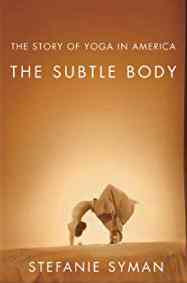
The Subtle Body: The Story of Yoga in America is a 2010 book on the history of yoga as exercise by the American journalist Stefanie Syman. It spans the period from the first precursors of American yoga, Ralph Waldo Emerson and Thoreau, the arrival of Vivekananda, the role of Hollywood with Indra Devi, the hippie generation, and the leaders of a revived but now postural yoga such as Bikram Choudhury and Pattabhi Jois.

Postural yoga began in India as a variant of traditional yoga, which was a mainly meditational practice; it has spread across the world and returned to the Indian subcontinent in different forms. The ancient Yoga Sutras of Patanjali mention yoga postures, asanas, only briefly, as meditation seats. Medieval Haṭha yoga made use of a small number of asanas alongside other techniques such as pranayama, shatkarmas, and mudras, but it was despised and almost extinct by the start of the 20th century. At that time, the revival of postural yoga was at first driven by Indian nationalism. Advocates such as Yogendra and Kuvalayananda made yoga acceptable in the 1920s, treating it as a medical subject. From the 1930s, the "father of modern yoga" Krishnamacharya developed a vigorous postural yoga, influenced by gymnastics, with transitions (vinyasas) that allowed one pose to flow into the next.


























